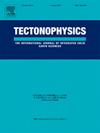Lithospheric control on the deep mantle carbon transfer in the Magadi-Natron basins, East Africa
IF 2.6
3区 地球科学
Q2 GEOCHEMISTRY & GEOPHYSICS
引用次数: 0
Abstract
Mantle-derived carbon dioxide (CO2) emissions during continental rifting are linked to climate change. The Archean cratonic mantle lithosphere has been considered a carbon reservoir that truncates ascending carbon-rich melts at its base, releasing huge amount of mantle CO2 in the surrounding rift basins. These emissions are believed to be remobilized from the carbon-rich cratonic lithosphere. However, the mechanisms by which mantle carbon is reactivated from the craton to the surrounding rift basins remain poorly understood. Hence, we conducted petrological-thermomechanical modeling to investigate the migration and decarbonation processes of the carbonate-metasomatized mantle lithosphere (CMML) across the craton-mobile belt boundary during continental rifting. The model results show that for a thicker, lighter, and higher water (H2O) content CMML, and a faster model extension, the CMML layer can be removed by the lateral advection and ascent from the craton margin to the rift basin formed in the adjacent mobile belt. Considering the 184 km long Magadi-Natron basins in East Africa, we observed that these processes generate a metamorphic CO2 degassing flux of 0.19–0.56 Mt./yr across the rift basins. Based on the model results, we suggest that the carbon transit from the Archean Tanzanian craton into the Proterozoic Mozambique Belt boundary may be explained by the CMML migration processes. Our modeled CO2 degassing flux provides lower bounds for the diffuse mantle CO2 flux along faults in the Magadi-Natron basins.
东非magadii - natron盆地深部地幔碳转移的岩石圈控制
大陆裂谷过程中地幔来源的二氧化碳(CO2)排放与气候变化有关。太古代克拉通地幔岩石圈被认为是一个碳储集层,它截断了底部上升的富碳熔体,向周围的裂谷盆地释放了大量的地幔二氧化碳。这些排放物被认为来自富含碳的克拉通岩石圈。然而,地幔碳从克拉通重新激活到周围裂谷盆地的机制仍然知之甚少。在此基础上,对大陆裂陷过程中碳酸盐岩交代地幔岩石圈(CMML)在克拉通—活动带边界的迁移和脱碳过程进行了岩石学—热力学模拟研究。模型结果表明,对于较厚、较轻、含水量较高的CMML,模型扩展速度较快的CMML层,可以通过克拉通边缘的横向平流和上升作用将CMML层移至相邻活动带形成的裂谷盆地。考虑到东非长184 km的magadii - natron盆地,我们观察到这些过程在裂谷盆地中产生了0.19-0.56 Mt./yr的变质CO2脱气通量。基于模型结果,我们认为太古宙坦桑尼亚克拉通向元古宙莫桑比克带边界的碳输运可以用CMML迁移过程来解释。模拟的CO2脱气通量为Magadi-Natron盆地沿断层扩散的地幔CO2通量提供了下限。
本文章由计算机程序翻译,如有差异,请以英文原文为准。
求助全文
约1分钟内获得全文
求助全文
来源期刊

Tectonophysics
地学-地球化学与地球物理
CiteScore
4.90
自引率
6.90%
发文量
300
审稿时长
6 months
期刊介绍:
The prime focus of Tectonophysics will be high-impact original research and reviews in the fields of kinematics, structure, composition, and dynamics of the solid arth at all scales. Tectonophysics particularly encourages submission of papers based on the integration of a multitude of geophysical, geological, geochemical, geodynamic, and geotectonic methods
 求助内容:
求助内容: 应助结果提醒方式:
应助结果提醒方式:


